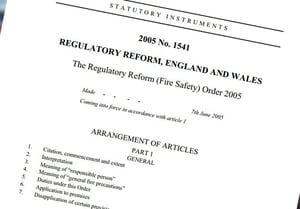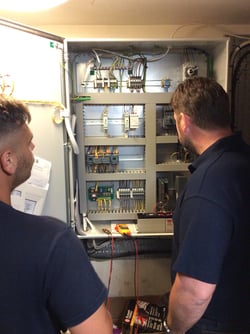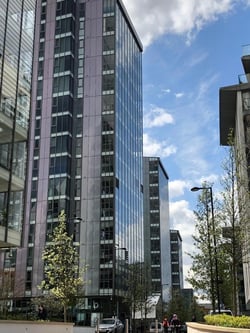 If you own or manage a commercial or residential property, you are ultimately responsible for the safety of the building's occupants and providing fire safety systems that are properly maintained and functioning.
If you own or manage a commercial or residential property, you are ultimately responsible for the safety of the building's occupants and providing fire safety systems that are properly maintained and functioning.
Workplace fire safety and smoke control maintenance regulations
The Regulatory Reform (Fire Safety) Order 2005 (“RRO”) covers fire safety for workplaces and replaced most of the pre-existing legislation. It sets out the role of the "responsible person" (usually the employer) tasked with ensuring the safety of occupants. As per the RRO, the "responsible person" is defined as:
a) in relation to a workplace, the employer, if the workplace is to any extent under his control;
(b) in relation to any premises not falling within paragraph (a)—

(i) the person who has control of the premises (as occupier or otherwise) in connection with the carrying on by him of a trade, business or other undertaking (for profit or not); or
(ii) the owner, where the person in control of the premises does not have control in connection with the carrying on by that person of a trade, business or other undertaking.
On the responsible person, the RRO places a duty to keep an up-to-date fire risk assessment for fire safety and to ensure that all fire safety systems (including smoke control systems) are regularly tested, maintained and kept in good working order. This role entrusts them to identify, manage and reduce the risk of fire. Furthermore, the DLUHC Guides to the regulations suggest that "The smoke control system should be maintained by a competent person who is familiar with the fire engineering performance specifications of that specific system."
The provisions of the RRO are not always understood; they are open to interpretation and guidance can be difficult to find. In order to help owners and occupiers to get a clear understanding of the RRO provisions relating to smoke control systems in workplaces, we have prepared a whitepaper, which summarises the main provisions of the RRO that relate to smoke control systems, written with the ‘responsible person’ in mind.
Download and read our short and informative whitepaper here.
Fire safety and smoke control maintenance in residential buildings
In addition to Regulatory Reform (Fire Safety) Order, the Government published a Consolidated Advice Note (CAN) in 2019, which can be viewed here.
 DLUHC have very recently withdrawn this CAN citing that it has “been wrongly interpreted and has driven a cautious approach to building safety that goes beyond what we consider necessary.”
DLUHC have very recently withdrawn this CAN citing that it has “been wrongly interpreted and has driven a cautious approach to building safety that goes beyond what we consider necessary.”
This may be the case for some aspects. However, the advice regarding smoke control systems is informative, sensible and very relevant. We do not believe it to drive anything other than a proportionate approach to the maintenance of smoke control systems.
The withdrawal coincides with the publication of PAS 9980, which provides new guidance on how to assess the risk of fire via an external wall of an existing multi-storey, multi-occupied residential building. In addition, the citation states that guidance will be made available later this year.
This advice on smoke control systems is mainly aimed at those who are responsible for residential buildings that are 18m or taller. But it may also apply to you as the owner of other types of buildings, if those buildings have, or should have, smoke control systems. If you are the owner of one of these buildings, it is essential that you know what the guidance contains. It explains that if you are the “responsible person” under the Regulatory Reform (Fire Safety) Order 2005, then you have a duty to ensure that appropriate fire measures are in place. It is also your duty to carry out a fire risk assessment. The order is the definitive guide to your responsibilities.
To start with, it lays out what a smoke control system is and explains where they are likely to be sited and how they operate.
The document talks about:
- the importance of regular maintenance, explaining that the standards are set out in BS 9999 and BS 9991 for residential buildings.
- Products for smoke control installations should be designed, tested and certified in accordance with the BS EN 12101 series of standards.
- You should test your smoke control systems weekly to make sure that they are working.
- In addition, you should have a full maintenance inspection and test annually, carried out by a competent person.
The guidance explains the problems that can occur with electromagnetic holding devices, saying ‘It is therefore recommended that the use of electromagnetic holding devices as part of any smoke ventilation shaft installation should be reviewed as part of fire risk assessments with consideration being given to replacing these devices with a more robust form of vent actuator.’ Our recommendation is to use products CE marked to EN12101 wherever practicable as these are designed, tested and manufactured to operate as a smoke control product.
Similarly, it warns that you need to review manual override controls for automatic smoke control systems to make sure that they are working and that fire fighters can find them easily.
Next, the guidance tells you what to do if you discover that there is a problem. Ideally, of course, it should be remedied immediately. But if it can’t be, then you should carry out an assessment to consider/decide if fire mitigation measures need to be put in place. Some of these may have knock-on effects on other elements of fire safety and it is important to consider these.
And finally, the advice says, you can get professional advice "from a qualified engineer with relevant experience in fire safety and the installation and maintenance of smoke control systems. They will normally be a chartered professional registered with the Institution of Fire Engineers but may include registered professionals from another built environment profession specialising in fire safety." You must get this advice from somebody who is deemed to be competent in the field. Colt is just such a company - we were the UK’s first company to be certified to both the IFC SDI19 and SDI05 standards that recognise competency in the design, installation and servicing of smoke control systems including smoke and fire curtains.
Put simply, this guidance tells you:
- that smoke control is important
- that you are responsible
- that you should check your system regularly and ensure that it is fully functioning at all material times
- that you should have proper annual maintenance done
- that if anything is wrong you should put it right
- and that you should get advice from a competent professional.
Bearing in mind the objective of smoke control systems are to assist escape and aid fire fighters, what could possibly be wrong with that advice? Whilst it may not be easy to be fully conversant with the machinations of the RRO, you should not forget about or ignore your responsibilities, the consequences could be dire if it is found that you have failed to comply.
Talk to Colt for expert advice - our engineers will carry out a full survey of your installation, checking for any irregularities or discrepancies and advise on the best course of action to remedy them. It may be that the installation is absolutely fine – in which case a certificate will be issued, and a maintenance schedule established to ensure your smoke control installations are safe and compliant.
